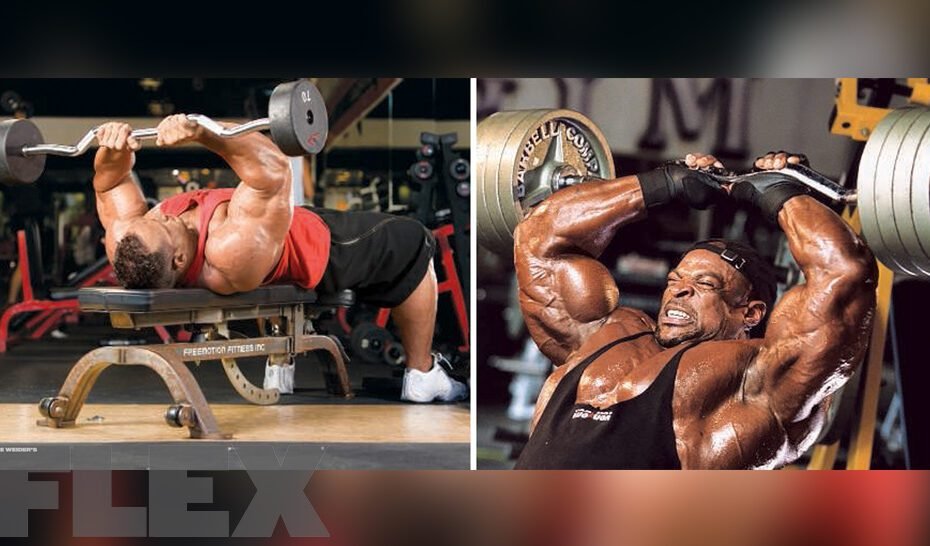The barbell triceps extension is a versatile exercise that comes in two distinct variations: lying and seated. Each variation offers unique benefits and challenges while primarily targeting the triceps brachii muscles. In this comprehensive guide, we’ll explore both the lying and seated versions, including the primary muscles engaged, proper techniques, benefits, safety considerations, alternatives, variations, and common mistakes associated with each.
Muscles Worked:
- Primary Muscle: Triceps Brachii
Lying Barbell Triceps Extension:
How to Perform Lying Barbell Triceps Extension:
Follow these steps to execute the lying barbell triceps extension with proper form:
- Setup: Lie on a bench with your head positioned at the edge. Grasp the barbell with an overhand grip and extend your arms fully above your chest.
- Bending Elbows: Gradually lower the barbell towards your forehead by bending your elbows. Keep your upper arms stationary throughout the movement.
- Extension: Engage your triceps to push the barbell back up by extending your elbows, returning to the starting position.
- Repeat the Movement: Complete the desired number of repetitions while maintaining controlled and steady motions.
Benefits:
- Isolated Triceps Engagement: Lying triceps extensions effectively isolate the triceps, contributing to enhanced strength and muscle definition.
- Full Range of Motion: This variation allows for a deep stretch of the triceps, optimizing muscle activation.
- Diverse Training: Lying triceps extensions complement other triceps exercises, providing a well-rounded triceps workout.
Seated Barbell Triceps Extension:
How to Perform Seated Barbell Triceps Extension:
Follow these steps to execute the seated barbell triceps extension with proper form:
- Setup: Sit on a bench with back support and grasp the barbell with an overhand grip. Hold the barbell above your head, arms fully extended.
- Bending Elbows: Gradually lower the barbell behind your head by bending your elbows. Maintain a stable upper arm position.
- Extension: Engage your triceps to push the barbell back up by extending your elbows, returning to the starting position.
- Repeat the Movement: Perform the desired number of repetitions while maintaining controlled movements.
Benefits:
- Focused Triceps Activation: Seated triceps extensions emphasize triceps engagement, promoting strength and definition.
- Stable Position: The seated position provides stability and minimizes the potential for using momentum during the exercise.
- Variety in Training: Seated triceps extensions introduce variety to your triceps workout, helping prevent plateaus.
Safety Tips:
To perform both variations safely, keep these tips in mind:
- Choose an appropriate barbell weight for your fitness level and goals.
- Maintain a controlled tempo during the entire movement, avoiding jerking motions.
- Use a spotter when lifting heavy weights to ensure safety.
- If you experience discomfort or pain, cease the exercise and consult a fitness professional or healthcare provider.
Alternative Exercises:
To diversify your triceps workout, consider these alternatives:
- Dumbbell Triceps Extensions: Use dumbbells for triceps extensions, providing a slightly different range of motion.
- Triceps Pushdowns: Utilize a cable machine for effective triceps isolation.
Common Mistakes:
Avoid these common mistakes in both variations:
- Excessive Weight: Choose a weight that allows you to maintain proper form.
- Elbow Flaring: Keep your elbows close to your body throughout the movement.
- Arching Lower Back: Maintain a stable back position to prevent excessive arching.
Choose between lying and seated barbell triceps extensions based on your preferences, fitness level, and equipment availability. Integrate these variations into your triceps-focused routine to elevate strength, muscle definition, and arm aesthetics. Focus on controlled form, gradual progression, and consulting fitness professionals or healthcare providers if you have any health concerns or injuries.
